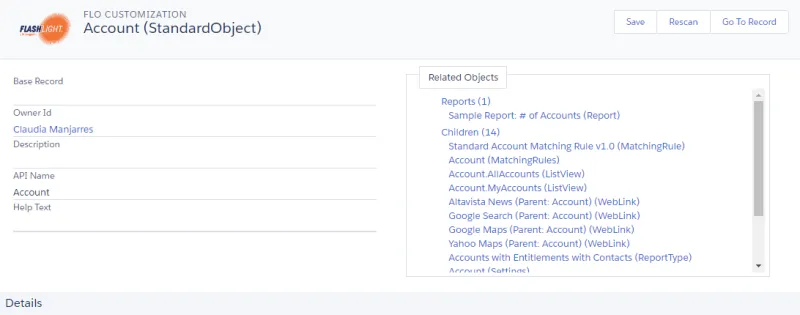Understanding the Customization Record
The customization detail contains general information about the customization record. The customization name appears in the banner with function buttons:
- Save: saves the customization record.
- Rescan: runs the scanner on the record. You are prompted to refresh the page.
- Go To Record: brings up the customization record for editing or to view additional details.
- Update Description and Help Text: editor to add or modify the Description and Help Text fields.
Customization record fields include:
- Base Record: Link to the base record for the customization.
- Owner ID: Link to the current owner.
- Description: Details added to the record. Click Update Description and Help Text to update.
- Salesforce Type: Customization type.
- API Name: APIs associated with the record.
- Help Text: Helpful information detailing function and use of each customization. Click Update Description and Help Text to update.
- Related Objects: Links to related objects.
- Details: Tabs to access details about the customization. Tabs include Metadata, Improvement, Permissions, Control, DRD, Raw Data and Related Lists.

Customization Record Tabs
These are the tabs inside a customization record:
Metadata
Improvements
Control
DRD
Raw Data
Related Lists
Metadata
The metadata tab provides the metadata information about the customization, including:
- Date Last Used: date the customization was last used. Refer to DLU for more information.
- Data type: data type of the custom field.
- Last Modified Date: last date the customization was modified.
- Active: indicates whether the customization is a active.
- Package: indicates the package (if any) of the customization.
- List: Custom/Standard list used as a data source by the customization.
- Last Modified File Date: last date the file was modified
- Customization Created By: user who created the customization.
- Customization Created Date: date the customization was created.
- Customization Last Modified By: user who last modified the customization.
- Script File Date: date the script file was last modified.
- Script File: primary script file for a script customization.
- Functions: functions used in the script.
- Script Fields: fields used in the script file.
- Attempt #: number of times the script has tried to execute.
- # of Lines: number of lines in the script.
- Manageable State: the current state if it is from a managed/unmanaged package.
Improvements
The improvement tab provides information about improvements that can be made on a customization such as clean up:
-
Clean Up Status: This is the clean-up status of customizations that are to be deleted.
-
Change/Approval Policy: This field designates the approval policy related to a customization.
-
Clean Up Comments: This field is used to make notes during clean up and improvements.
-
Clean-up Classification: This field shows an overview of the clean-up classification.
-
Add to Change Request: Lookup tool to associate the clean up to an existing change request.
-
: This is one or more Customization records representing the data source(s) for this particular field.
Control
The control tab describes assigned controls on a customization record for example controls assigned on a financial report.
- Control: determines if the customization is a control.
- Control Frequency: frequency at which a control should be checked.
- Track Duplicates: specifies whether duplicate issues are to be tracked or not.
- Control Type: select count to record numbers, issues, tasks etc.
- Control Assignee: assign tasks, issues or alerts to someone other than the owner, if blank the control alerts the owner of the customization.
- Controlled Process: process this customization controls.
- Control Count: custom field created for the account.
- Alert Control Owner: check box to alert owner of the control.
- Next Control Date Time: notes the date and time when to start monitoring.
- Risk/Requirement: process issue associated with the customization.
- Last Control Run Date: This is the last date the control was run.
- Alert Process Owner: check box to alert the process owner whenever an incident is detected.
- Alert/Task Message: The message that will be sent to the assignee on tasks or recipients of alerts.
- Instructions for Resolution: instructions for resolving the issue.
- Control Error/Warning: errors or warnings encountered when control was last run. Blank indicates no errors/warnings.
DRD
Dependency Relationship Diagram (DRD) displays objects, customizations and their relationships and dependencies.
Raw Data
This tab describes and list the XML code contained in a customization.
- Last Scanner Date: Last date in which the scanner ran and evaluated the current customization.
- Rescanner: information for rescanning the customization and evaluating progress of Apex Batches to show In Progress.
- Make Join Date: date customization was last passed to Make Join script.
- Incomplete Object: checked if the object is incomplete.
- Suppress Changelog: prevent changes from being made.
- Script Fields (Raw): fields in the relevant script file.
- Scripts (Raw): scripts used by other customizations.
- Workflow/Approval Fields (Raw): data workflow fields.
- Workflow Scripts (Raw): data workflow scripts.
- Extended Types Fields (Raw): CSV of fields used by a customization.
- Report/Search Fields (Raw): fields used in filter criteria or columns for a search.
- Layout (Raw): custom field to hold custom fields of ListView, visual pages and layouts.
- List (Raw): references related to this field.
- Scanner Read: check box to indicate if the retrieve and the customization was executed and read.
- Folder File Name: name of the folder and file where Salesforce has the Metadata component.
- Encoded API Name: field to note the retrieve with encoded API name.
- XML/Code: XML/code representation of the page for a customization.
Related Lists
Links to related lists: Change Logs, Notes & Attachments and Customization History.